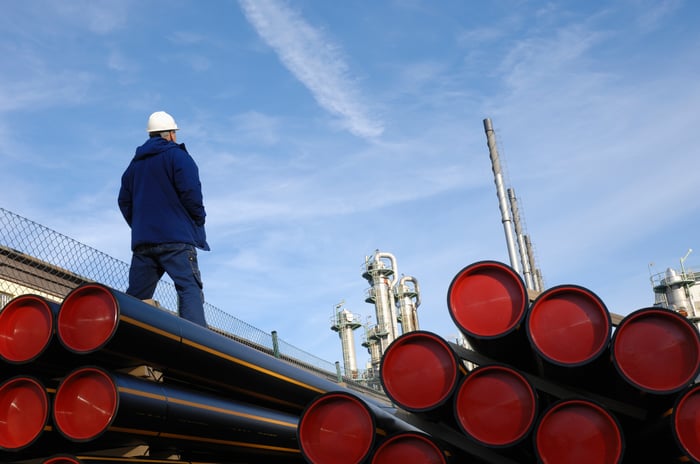Energy Transfer (ET 1.97%) recently wrapped up an excellent year. The pipeline company delivered record-setting fourth-quarter results, which pushed its earnings and cash flow up nearly 30% from 2017. Meanwhile, with a large slate of expansion projects currently under construction, the company anticipates delivering another double-digit increase in earnings this year.
The company's management team is working hard to keep its growth engine well fueled so that it can continue expanding at a healthy rate for many years to come. They provided some insight into a few of their development initiatives on the fourth-quarter call, outlining three areas that could be important future growth drivers.
Check out the latest earnings call transcript for Energy Transfer.

Image source: Getty Images.
1. We're looking to expand our recent expansions
CFO Tom Long noted on the call that the company recently completed several expansion-related initiatives. Highlights included increasing the capacity of its Bakken pipeline up to 570,000 barrels per day (BPD) and finishing a sixth natural gas liquids (NGL) fractionator at its Lone Star complex that will separate 150,000 BPD of raw NGLs into finished products like ethane and propane.
However, despite recently finishing these capacity expansions, Energy Transfer sees more growth ahead for these two areas. At Lonestar, for example, the company already locked up enough customers to move forward with a seventh fractionator. Long also noted that "we continue to evaluate further expansions of our frack capacity due to the strong demand from customers." Meanwhile, on the Bakken system, he stated that "continued basin production growth" drove shipper demand:
Continued basin production growth and fourth-quarter differentials drove nominations in excess of our available capacity during the fourth quarter. This demand, as well as incredible demand for capacity during our recent open season, further highlights the need for additional takeaway capacity out of the basin. As a result, we are looking at increasing system capacity to serve this growing demand, and we'll make that decision at the appropriate time.
These expansions of existing assets tend to generate high returns on investment, which makes them ideal ways to boost cash flow.
2. We're considering joining forces to build one massive pipeline
Long also noted that Energy Transfer's Permian Gulf Coast pipeline project joint venture with Magellan Midstream Partners (MMP), MPLX, and Delek is continuing to pursue additional shipper commitments to fill up the proposed capacity of this 600-mile pipeline. The currently envisioned project "will provide unprecedented flexibility from the Permian Basin for deliveries to both Energy Transfer's Nederland terminal as well as Magellan's East Houston terminal and ultimate delivery through our respective distribution systems," according to Long, as well as "provide shipper capacity to our storage facilities and pipeline header systems at Nederland."
However, Long stated that the company is also in discussions with Exxon Mobil (XOM -0.09%) and Plains All American Pipeline (PAA 1.90%) to potentially join their Wink to Webster Pipeline project. Long stated that "we will continue to go down parallel paths in order to evaluate and achieve the most efficient and accretive [project] for our partnership."
COO Mackie McCrea provided some more insight as to why the company is considering joining Exxon and Plains All American. He stated that:
We're trying to decide what's the best way to go. One would require more capital with not as good a rate of return. The other is less capital with a lot better rate of return.
Either way, Energy Transfer will move forward with a new oil pipeline. The company could opt to stay the course with its current project, since it already has enough customers to justify the investment or combine that pipeline with Exxon's since that could generate even higher returns.

Image source: Getty Images.
3. We're working on giving Lake Charles the green light
An even larger-scale project that Energy Transfer has in development is converting its Lake Charles facility to export liquified natural gas (LNG). The company's general counsel, Tom Mason, weighed in on where the company stands with this one:
We were somewhat frustrated with the pace of progress with Shell (RDS.A) (RDS.B) as our joint development partner on the project, but we've really turned the corner on that front and we've made a lot of progress with Shell... And so I think that will help us move the project forward as well... It's a big project, and there are lots of moving parts to it. But we're pleased with the progress and we think we'll have some developments to announce in the near future. But I think we're looking at hopefully an FID [final investment decision] in the first half of 2020. And we think that's very achievable.
That would put the project on track to come online and start generating cash flow in the late-2024 or early-2025 time frame. Sanctioning that project would not only further diversify Energy Transfer's business, but enhance its long-term growth and cash flow prospects.
Plenty of growth ahead
Energy Transfer has invested billions of dollars in expanding its energy infrastructure portfolio over the years, which is starting to pay big dividends now that the company's cash flow is growing at a fast pace. However, if there was one thing management made clear on the fourth-quarter call, it's that Energy Transfer has plenty of fuel to keep growing over the coming years. That makes the company an intriguing option for both growth and income-focused investors to consider buying.





